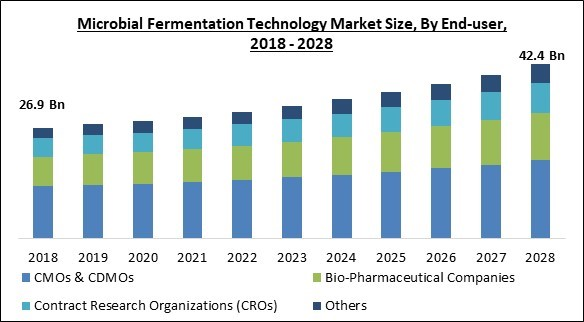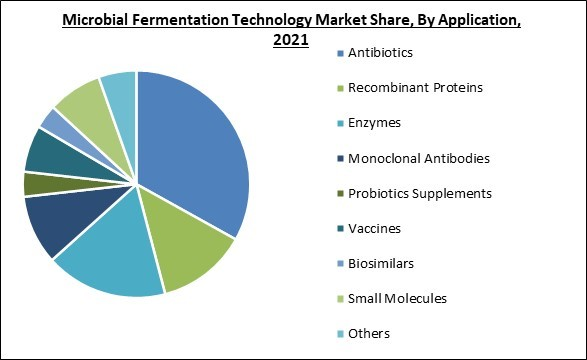The Global Microbial Fermentation Technology Market size is expected to reach $42.4 billion by 2028, rising at a market growth of 5.4% CAGR during the forecast period.
Microbial fermentation technologyis novel, promising, and increasing quickly. This fielduses microbes to produce substances with enormous applications in manufacturing biofuels, pharmaceuticals, environmentally friendly materials, fine chemicals, energy,and the food sector. For decades, this technology has been employed in producing highly prized goods. Still, to accomplish the shift to a bio-based society, it is urgently necessary to dramatically speed this technology's development.
Also, there is constant interest in and demand for developing novel microbial fermentation methods for several crucial reasons, including the potential to produce novel compounds and the sustainability element. One of the most crucial elements of contemporary biotechnology is fermentation engineering, which has been widely used in manyfields.
Many techniques, like product and substrate evaluation, microscopy,toxicity tests, or biomass monitoring, help to provide a comprehensive image of the traits and requirements of the strains and allow control over specific fermentation processes. Yeasts are single-cell microorganisms that participate in pulque fermentation by producing ethanol and carbon dioxide while also assisting bacterial growth by creating vitamins, amino acids, and other metabolites.
They also provide the necessary aromatic constituents and proteolytic and lipolytic activities. The processes used to ferment yeast include alcoholic fermentations like beer, wine, and cider fermentation, as well as non-alcoholic yeast fermentations like coffee, bread, and chocolate fermentation. Yeasts are unicellular, eukaryoticmicrofungi found all over the natural world. They are part of the class of organisms known as fungi, which also include mushrooms andmolds.
The market research report covers the analysis of key stake holders of the market. Key companies profiled in the report include Biocon Limited, BioVectra Inc. (H.I.G. Capital, LLC), Danone S.A., F. Hoffmann-La Roche Ltd., Koninklijke DSM N.V., Lonza Group AG, Novozymes A/S (Novo Holdings A/S), Corbion N.V., and Bangalore Biotech Labs Pvt. Ltd. (BiOZEEN).
Microbial fermentation technologyis novel, promising, and increasing quickly. This fielduses microbes to produce substances with enormous applications in manufacturing biofuels, pharmaceuticals, environmentally friendly materials, fine chemicals, energy,and the food sector. For decades, this technology has been employed in producing highly prized goods. Still, to accomplish the shift to a bio-based society, it is urgently necessary to dramatically speed this technology's development.
Also, there is constant interest in and demand for developing novel microbial fermentation methods for several crucial reasons, including the potential to produce novel compounds and the sustainability element. One of the most crucial elements of contemporary biotechnology is fermentation engineering, which has been widely used in manyfields.
Many techniques, like product and substrate evaluation, microscopy,toxicity tests, or biomass monitoring, help to provide a comprehensive image of the traits and requirements of the strains and allow control over specific fermentation processes. Yeasts are single-cell microorganisms that participate in pulque fermentation by producing ethanol and carbon dioxide while also assisting bacterial growth by creating vitamins, amino acids, and other metabolites.
They also provide the necessary aromatic constituents and proteolytic and lipolytic activities. The processes used to ferment yeast include alcoholic fermentations like beer, wine, and cider fermentation, as well as non-alcoholic yeast fermentations like coffee, bread, and chocolate fermentation. Yeasts are unicellular, eukaryoticmicrofungi found all over the natural world. They are part of the class of organisms known as fungi, which also include mushrooms andmolds.
COVID-19 Impact Analysis
Markets worldwide started focusing onmicrobial strain production technology as it increasedthe output of microbial-based medications. Additionally, the governmentsupports both small and large biotechnology companies in researching vaccinations, medicines, and products that improve gut health and boost immunity. Therefore, the pandemic aided in speeding up the R&D processes associated with the technology. But the closure of industries and disruptions of supply chains prevented the use of technology in any other sector. As a result, the pandemic had a moderate impact on the microbial fermentation technology market.Market Growth Factors
Increasing demand for alcoholic beverages
Demand for alcoholic beverages has increased in establishments like hotels, restaurants, taverns, and pubs. Every year, wine, spirits, and beer are consumed worldwide in amounts of about 446 billion liters. Beer, lagers, and cider account for about 400 billion liters of all alcohol consumed, with wine and spirits coming in second and third, respectively. Additionally, the industry for alcoholic beverages is predicted to rise due to the growing demand for artisanal spirits in many developing nations. Therefore, as the demand for alcoholic beverages rises, it will propel the demand for microbial fermentation technology, which will ensure the market's growth.Rising utilization of technology in food enrichment
The amount of protein in mechanically controlled canola meal increased after solid-state fermentation using Pleurotus ostreatus, and the amounts of glucosinolates and phytate decreased by up to 98.8% and 75.8%, respectively. In soybean meal (SBM), solid-state fermentation boosted the amino acid and protein content, with B. subtilis having a bigger influence than A. oryzae. These established experimental results have expanded the use cases for microbial fermentation technology. Hence, the microbial fermentation technology market will expand in the coming years owing to all these factors.Market Restraining Factor
Issues associated with the fermentation process
Fermented products can be contaminated over time as they undergo continual natural variations. However, contamination through contamination sources is easy even if no variation occurs. Additionally, the product needs more processing because it is impure. The result was unintended and unpleasant; bad germs grew and multiplied while beneficial microbes perished. Some common fermentation processes, like solid state fermentation, have some drawbacks, including using microorganisms that can only withstand low moisture levels and the inability to precisely monitor SSF. Therefore, such difficulties associated with the microbial fermentation processes may hamper the market's growth in the coming years.Application Outlook
Based on application, the microbial fermentation technology market is categorized into antibiotics, probiotics supplements, monoclonal antibodies, recombinant proteins, biosimilars, vaccines, enzymes, small molecules, and others. The monoclonal antibodies segment procured a considerable growth rate in the microbial fermentation technology market in 2021. One of the most useful biologics for various applications is monoclonal antibodies. These compounds' high binding affinity, selectivity, and specificity often make them advantageous.End-user Outlook
On the basis of end-user, the microbial fermentation technology market is divided into bio-pharmaceutical companies, contract research organizations (CROs), CMOs & CDMOs, and academic & research institutes. The contract manufacturing organizations (CROs) and contract development & manufacturing organization (CDMOs) segment witnessed the largest revenue share in the microbial fermentation technology market in 2021. CMOs and CDMOs are quickly evolving into the preferred choice for biotherapeutics producers because the majority of the invention in the bioprocess industry is produced by smaller businesses that lack the capacity, skilled personnel, and resources necessary for the development of these products.Regional Outlook
Region wise, the microbial fermentation technology market is analyzed across North America, Europe, Asia Pacific, and LAMEA. The Asia Pacific segment procured the maximum revenue share in the microbial fermentation technology market in 2021. This results from acknowledging Asian nations as a center for outsourcing in the biopharmaceutical industry. An estimated 50% of new bioprocessing facilities worldwide are being built by Asian businesses, including domestic competitors and international powerhouses. For example, China plans to build several bioprocessing facilities to accommodate domestic demand.The market research report covers the analysis of key stake holders of the market. Key companies profiled in the report include Biocon Limited, BioVectra Inc. (H.I.G. Capital, LLC), Danone S.A., F. Hoffmann-La Roche Ltd., Koninklijke DSM N.V., Lonza Group AG, Novozymes A/S (Novo Holdings A/S), Corbion N.V., and Bangalore Biotech Labs Pvt. Ltd. (BiOZEEN).
Recent Strategies Deployed in Microbial Fermentation Technology Market
- Feb-2023: Danone opened a new Research and Innovation Center in Paris. The new research center would enable the company to develop and innovate fresh dairy and plant-based products and 'natural mineral water' categories.
- Nov-2022: Biocon took over Viatris, Inc., an American pharmaceutical and healthcare corporation. The acquisition enables the company to emerge as a leading biosimilar player with eight commercialized products. Additionally, it would improve the research and development, global-scale manufacturing, and commercialization abilities of the company.
- Nov-2022: BioVectra Inc. unveiled single-use fermentation microbial technology. The new technology contains 100 L and 1,000 L single-use fermenters. The single-use fermentation microbial technology would allow the company to provide greater flexibility, faster turnaround times, and increased capacity utilization to its customers.
- Jul-2022: Novozymes introduced Innova Apex and Innova Turbo. The two new advanced yeasts are intended to break down fermentation bottlenecks and at the same time decrease the demand for urea and improve ethanol yield. The yeasts maximize the fermentation process, thereby enabling ethanol producers to achieve their production targets. The Innova Apex pushes the plant to 36 & dry solids and decreases glycerol by 38%.
- Sep-2021: BioVectra signed an agreement with ABEC, a customized process solutions and services provider. The integration of ABEC CSR single-use fermentation solutions would enhance BIOVECTRA’s high-growth microbial fermentation processes and would enable the company to offer a turnaround product to product and between batches.
- Apr-2019: BioVectra Inc. expanded its geographical footprints in Windsor, Canada. The new manufacturing facility enables the company to manufacture substances to be used in developing treatments for cancer, autoimmune diseases, and diabetes.
- Mar-2019: DSM and Cargill, agricultural, financial, and industrial products provider, together launches Avansya, a producer of produce zero-calorie, great-tasting sweeteners through fermentation. Avansya would produce sweet-tasting molecules, such as steviol glycosides Reb M and Reb D through a fermentation process.
Scope of the Study
By Application
- Antibiotics
- Recombinant Proteins
- Enzymes
- Monoclonal Antibodies
- Probiotics Supplements
- Vaccines
- Biosimilars
- Small Molecules
- Others
By End-user
- CMOs & CDMOs
- Bio-Pharmaceutical Companies
- Contract Research Organizations (CROs)
- Others
By Geography
- North America
- US
- Canada
- Mexico
- Rest of North America
- Europe
- Germany
- UK
- France
- Russia
- Spain
- Italy
- Rest of Europe
- Asia Pacific
- China
- Japan
- India
- South Korea
- Singapore
- Malaysia
- Rest of Asia Pacific
- LAMEA
- Brazil
- Argentina
- UAE
- Saudi Arabia
- South Africa
- Nigeria
- Rest of LAMEA
Key Market Players
List of Companies Profiled in the Report:
- Biocon Limited
- BioVectra Inc. (H.I.G. Capital, LLC)
- Danone S.A.
- F. Hoffmann-La Roche Ltd.
- Koninklijke DSM N.V.
- Lonza Group AG
- Novozymes A/S (Novo Holdings A/S)
- Corbion N.V.
- Bangalore Biotech Labs Pvt. Ltd. (BiOZEEN)
Unique Offerings
- Exhaustive coverage
- The highest number of market tables and figures
- Subscription-based model available
- Guaranteed best price
- Assured post sales research support with 10% customization free
Table of Contents
Chapter 1. Market Scope & Methodology
Chapter 2. Market Overview
Chapter 4. Global Microbial Fermentation Technology Market by Application
Chapter 5. Global Microbial Fermentation Technology Market by End-user
Chapter 6. Global Microbial Fermentation Technology Market by Region
Chapter 7. Company Profiles
Companies Mentioned
- Biocon Limited
- BioVectra Inc. (H.I.G. Capital, LLC)
- Danone S.A.
- F. Hoffmann-La Roche Ltd.
- Koninklijke DSM N.V.
- Lonza Group AG
- Novozymes A/S (Novo Holdings A/S)
- Corbion N.V.
- Bangalore Biotech Labs Pvt. Ltd. (BiOZEEN)










